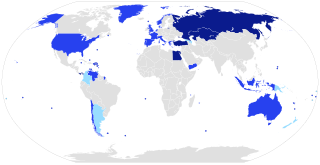 W
WThis is a list of countries and territories by land borders. The number of distinct land borders of each country or territory is indicated as well the names of its neighbouring countries and territories. The length of each land border is included, as is the total length of each country's and territory's land borders.
 W
WThis article contains a list of countries by length of coastline, in kilometers. A coastline of zero indicates that the country is landlocked.
 W
WThe following sortable table lists land surface elevation extremes by country or dependent territory.
 W
WSeveral empires in world history have been contenders for the largest of all time, depending on definition and mode of measurement. Possible ways of measuring size include area, population, economy, and power. Of these, area is the most commonly used because it has a fairly precise definition and can be feasibly measured with some degree of accuracy. Estonian political scientist Rein Taagepera, who published a series of academic articles about the territorial extents of historical empires between 1978 and 1997, defined an empire as "any relatively large sovereign political entity whose components are not sovereign" and its size as the area over which the empire has some undisputed military and taxation prerogatives; these are the criteria from which these lists are formed. The list is not exhaustive owing to a lack of available data for several empires; for this reason and because of the inherent uncertainty in the area estimates, no rankings are given.
 W
WThis article is a list of countries by forest area.
 W
WThis article is a list of countries by forest area (percentage). Types of places listed include the entire planet, continents, regions, countries, provinces, states, and territories. Percentage data was calculated using information from the CIA's World Factbook 2011.
 W
WThis is a list of countries by irrigated land area based on The World Factbook of the Central Intelligence Agency as of 2012. The two countries with the largest irrigated land area are China and India, which make up 21.3% and 20.6% of worldwide irrigated land area respectively. Non-sovereign territories are not ranked and are shown in italics.
 W
WThis is a list of island countries. An island is a landmass that is surrounded by water. Many island countries are spread over an archipelago, as is the case with the Federated States of Micronesia and Indonesia. Others consist of a single island, such as Barbados, or part of an island, such as the Dominican Republic. Australia is a a continent, although it is sometimes referred to as an island, as it has no land borders. Two island countries, Northern Cyprus and Taiwan, are not universally recognized as politically independent, but have de facto control over their island territories. Indonesia is the world's largest island country by area, by total number the islands and is the world's most populous island country, with a population of 267,670,543.
 W
WThe Mediterranean countries are those that surround the Mediterranean Sea. Twenty sovereign countries in Southern Europe, the Levant and North Africa regions border the Mediterranean, in addition to two island nations completely located in it.
 W
WThis is a list of countries located on more than one continent, known as transcontinental states or intercontinental states. While there are many countries with non-contiguous overseas territories fitting this definition, only a limited number of countries have territory straddling an overland continental boundary, most commonly the line that separates Europe and Asia.